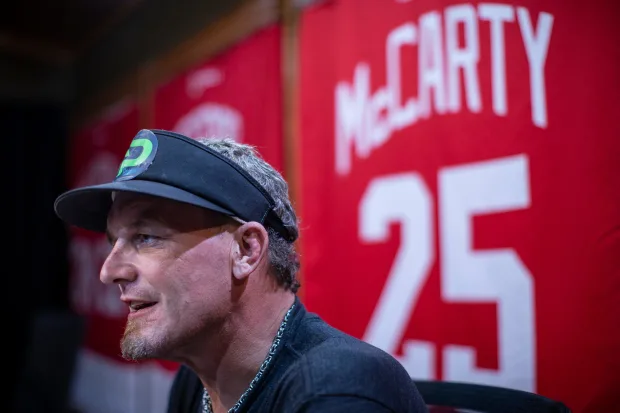
Darren McCarty, the legendary Detroit Red Wings enforcer who played an instrumental role in the team’s Stanley Cup victories during the late 1990s and early 2000s, shocked the sports world with a recent health-related announcement. The 52-year-old, whose career was defined by his physical play and tough persona, has revealed that he is battling a serious health issue that he had been privately struggling with for some time. McCarty’s transparency and courage in revealing his health condition have sparked a mix of reactions from fans, media, and health experts alike. But the question remains: what does McCarty’s revelation mean for both his legacy and the wider conversation about athlete health?
McCarty’s Announcement: A Personal Struggle
In a heartfelt statement, McCarty disclosed that he had been diagnosed with a condition that had been taking a toll on his well-being for years. While he did not initially specify the full details, rumors quickly surfaced that he is dealing with the lingering effects of chronic traumatic encephalopathy (CTE), a neurodegenerative disease linked to repeated head trauma, which is common among professional hockey players and other contact sport athletes. Though McCarty has yet to publicly confirm this, the speculation only adds to the broader conversation about the dangers of concussions and head injuries in hockey.
McCarty’s disclosure is especially significant because of his long history of being the type of player who never backed down from a fight. His reputation as one of the league’s toughest players is well-known, having spent years in the trenches for the Red Wings, notably during the infamous “Brawl in Hockeytown” against the Colorado Avalanche in 1997. Over the course of his career, McCarty was involved in numerous physical altercations, many of which resulted in concussions and injuries that are now part of the growing narrative surrounding player safety in hockey.
The Controversial Issue of Player Safety in the NHL
McCarty’s announcement has reignited the debate over the culture of violence in hockey and the long-term impact it has on players’ health. For years, the NHL has been criticized for downplaying the risks associated with fighting, headshots, and concussions. McCarty himself has expressed his regret over some of the violent aspects of the game that he was a part of, admitting that the “tough guy” role often led him to push his body beyond safe limits.
The NHL, like many other sports leagues, has gradually taken steps to address head injuries, but many critics argue that the changes have been too slow and insufficient. Despite some rule changes, such as banning hits to the head and tightening penalties for fighting, the NHL still allows players to engage in fisticuffs, a practice that remains deeply ingrained in the sport’s culture.
Darren McCarty’s health announcement serves as a stark reminder of the lasting consequences of these practices. The league’s handling of player safety has long been a topic of controversy, with many pointing to its history of reluctance in fully addressing the risks involved in contact sports. McCarty’s condition, if indeed linked to CTE, could serve as a pivotal turning point in the conversation about the need for further reform.
The Unseen Toll of Athletic Fame
It’s important to note that McCarty’s health struggles aren’t limited to his on-ice career. Like many former professional athletes, he has faced significant mental health challenges after retiring from the sport. In the past, McCarty has openly discussed his battles with addiction, particularly his struggle with alcohol and drugs. His candidness in confronting these issues has helped to destigmatize the challenges that many athletes face after their careers end.
McCarty’s health announcement brings to light the broader issue of mental health in sports. The pressure to perform at the highest levels, the physical toll of professional athletics, and the sudden shift to life after the game can all contribute to emotional and psychological challenges. In McCarty’s case, his openness about both his addiction and his health issues may encourage others in the sports world to seek help and embrace vulnerability.
The Media’s Role in the Conversation
While McCarty’s announcement has sparked significant media attention, it has also highlighted the often problematic nature of the way the press handles such issues. Some outlets have rushed to sensationalize McCarty’s condition, with headlines that appear more interested in exploiting the tragedy than in offering a thoughtful analysis of the implications for the sport. It’s crucial that the media treat these matters with the respect and sensitivity they deserve, focusing on the larger conversations about player safety, mental health, and the long-term effects of the physical toll that hockey and other sports take on their athletes.
At the same time, some commentators have praised McCarty for being a trailblazer by coming forward, suggesting that his story could push the NHL and other sports leagues to finally take concrete steps in addressing athlete health. McCarty’s decision to share his struggles could set a precedent for other athletes to follow suit, creating an environment where player health—both physical and mental—becomes a central concern for everyone involved in the sport.
Moving Forward: What McCarty’s Story Means for the Future
Darren McCarty’s health announcement is a reminder that even the toughest athletes are not immune to the long-term consequences of their careers. Whether or not McCarty’s condition is directly linked to CTE, his story underscores the importance of continuing to examine the risks involved in contact sports and the need for a comprehensive approach to player safety.
As fans, we can choose to celebrate McCarty’s legacy, not just as a fighter on the ice, but as someone who is willing to use his platform to address the difficult realities of life after hockey. For the NHL, McCarty’s story should serve as a wake-up call—a reminder that the fight for player safety is far from over.






